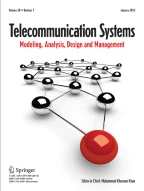- Hossein Akhlaghpasand ORCID:orcid.org/0000-0001-8765-08471 &
- S. Mohammad Razavizadeh ORCID:orcid.org/0000-0002-1732-47791
315Accesses
Abstract
This paper considers the contaminated channel estimation in multicell very large multiuser multiple-input multiple-output networks. To provide desirable spectral efficiency of these systems, we propose two adaptive algorithms which their implementations do not require orthogonal pilot sequences. The first algorithm (i.e., normalized least mean square) has low complexity and also gives an acceptable spectral efficiency in channels with low attenuation. The second algorithm (i.e., recursive least square) is more robust against pilot contamination and provides the desirable spectral efficiency in very large number of antennas at the base stations. In simulations, the performance of the proposed algorithms is evaluated and also compared with the performance of the conventional minimum mean square error estimation.
This is a preview of subscription content,log in via an institution to check access.
Access this article
Subscribe and save
- Get 10 units per month
- Download Article/Chapter or eBook
- 1 Unit = 1 Article or 1 Chapter
- Cancel anytime
Buy Now
Price includes VAT (Japan)
Instant access to the full article PDF.






Similar content being viewed by others
Explore related subjects
Discover the latest articles, news and stories from top researchers in related subjects.References
Larsson, E. G., Edfors, O., Tufvesson, F., & Marzetta, T. L. (2014). Massive MIMO for next generation wireless systems.IEEE Communication Magazine,52(2), 186–195.
Ngo, H. Q., Larsson, E. G., & Marzetta, T. L. (2013). Energy and spectral efficiency of very large multiuser MIMO systems.IEEE Transactions on Communication,61(4), 1436–1449.
Rusek, F., Persson, D., Lau, B. K., Larsson, E. G., Marzetta, T. L., Edfors, O., et al. (2013). Scaling up MIMO: Opportunities and challenges with very large arrays.IEEE Signal Processing Magazine,30(1), 40–60.
Marzetta, T. L. (2010). Noncooperative cellular wireless with unlimited numbers of base station antennas.IEEE Transactions on Wireless Communication,9(11), 3590–3600.
Mochaourab, R., Björnson, E., & Bengtsson, M. (2015). Adaptive pilot clustering in heterogeneous massive MIMO networks.IEEE Transactions on Wireless Communication,15(8), 5555–5568.
Yin, H., Gesbert, D., Filippou, M., & Liu, Y. (2013). A coordinated approach to channel estimation in large-scale multiple-antenna systems.IEEE Journal on Selected Areas Communication,31(2), 264–273.
Krishnan, N., Yates, R. D., & Mandayam, N. B. (2014). Uplink linear receivers for multi-cell multiuser MIMO with pilot contamination: Large system analysis.IEEE Transactions on Wireless Communication,13(8), 4360–4373.
Björnson, E., Larsson, E. G., & Marzetta, T. L. (2016). Massive MIMO: Ten myths and one critical question.IEEE Communication Magazine,54(2), 114–123.
Pirzadeh, H., Razavizadeh, S. M., & Björnson, E. (2016). Subverting massive MIMO by smart jamming.IEEE Wireless Communication Letters,5(1), 20–23.
Kay, S. M. (1993).Fundamentals of statistical signal processing: Estimation theory. Englewood Cliffs, NJ: Prentice-Hall.
Farhang-Boroujeny, B. (1998).Adaptive filters: Theory and applications. Chichester, U.K.: Wiley.
Ngo, H. Q., Matthaiou, M., & Larsson, E. G. (2014). Massive MIMO with optimal power and training duration allocation.IEEE Communication Letters,3(6), 605–608.
Jose, J., Ashikhmin, A., Marzetta, T. L., & Vishwanath, S. (2011). Pilot contamination and precoding in multi-cell TDD systems.IEEE Transactions on Wireless Communications,10(8), 2640–2651.
Author information
Authors and Affiliations
School of Electrical Engineering, Iran University of Science and Technology (IUST), Narmak, Tehran, 16846-13114, Iran
Hossein Akhlaghpasand & S. Mohammad Razavizadeh
- Hossein Akhlaghpasand
You can also search for this author inPubMed Google Scholar
- S. Mohammad Razavizadeh
You can also search for this author inPubMed Google Scholar
Corresponding author
Correspondence toS. Mohammad Razavizadeh.
Rights and permissions
About this article
Cite this article
Akhlaghpasand, H., Razavizadeh, S.M. Adaptive pilot decontamination in multi-cell massive MIMO networks.Telecommun Syst66, 515–522 (2017). https://doi.org/10.1007/s11235-017-0302-7
Published:
Issue Date:
Share this article
Anyone you share the following link with will be able to read this content:
Sorry, a shareable link is not currently available for this article.
Provided by the Springer Nature SharedIt content-sharing initiative


